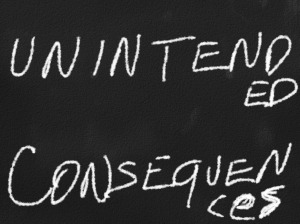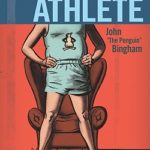 Unintended consequences can be roughly grouped into three types:
Unintended consequences can be roughly grouped into three types:
* A positive, unexpected benefit
* A negative, unexpected detriment occurring in addition to the desired effect
* A perverse effect contrary to what was originally intended (when a solution makes a problem worse)
It may be hard to believe but getting active – running, walking, bicycling – was filled with unintended consequences for me. And, to be honest, there were positive, negative, and even some perverse effects of starting to live a healthy, active lifestyle.
As I’ve written, for me there wasn’t some blinding epiphany. I didn’t have a heart attack, or some other dramatic medical event that convinced me that I needed to change. I wasn’t miserable or depressed or even marginally unhappy. It’s hard to be unhappy when your happiness lies in the next cigarette or beer or cheese danish.
At 43 years-old, my life, like so many other lives, had been a mix of successes and failures in nearly equal measure. I had had, and lost or left, good jobs and bad jobs, good relationships and bad relationships, and moments of pure joy and abject sorrow. You know, a normal life.
All of this was happening in the context of sitting still. Even at my most active, riding the motorcycles that I loved so dearly, I was still sitting still. I sat still when I worked, I sat still when I played, I even sat still on the garden tractor when I mowed the lawn. You see, activity and movement were not a part of my life and when forced to move, say to shovel snow from the driveway, I did it reluctantly and with great complaining.
Unlike many people I meet, I did NOT start running in order to lose weight. I started running to be able to run. I didn’t know how far I wanted to run, or how fast I wanted to run. I just knew that I wanted to run. Being as overweight as I was my desire did not match up with my ability so I did a lot more walking than running. It didn’t matter. The goal was to be able to run and walking was a way to reach that goal.

I figured out pretty quickly that being over-weight and running weren’t especially compatible. I made the decision to lose weight because I wanted to be a better runner. It’s an important distinction because so many people start running in order to lose weight only to discover that they start gaining weight. This is especially true when new runners start a long distance training program, say for a half or full marathon.
I also didn’t quit smoking when I started to run. It was much later that I concluded that I could improve my 5K time by not smoking as much. I eventually quit smoking all together because it no longer provided the pleasure it once did because it had a negative effect on my running.
The intended consequence was to become a runner. The positive unintended consequence was that I became a thinner, non-smoker who made better choices about what – and more importantly – how much I ate.
The negative unintended consequence was overuse injuries. Plantar Faciitis, IT Band Syndrome, inflamed bursa in my hips to name just a few. I thought to get good at running you had to do lots and lots of running. I read books about elite runners putting in over a hundred miles a week. I didn’t expect to be elite, but I thought I could train like one.
And that led to the perverse unintended consequence which was, indeed, contrary to what was originally intended. By running too much I eventually couldn’t run at all.
Becoming an adult-onset athlete is tricky business. At first the movement, any movement, feels awkward and unnatural. It doesn’t feel good but we convince ourselves it’s doing some good. The aches and pains and injuries, we tell ourselves, are the admission price to living as an athlete. It’s only later that we learn that they’re not.
The danger is that in doing what we want to do we will find ourselves not being able to do it.
Waddle on, friends.
Read more at: JohnBingham.com













